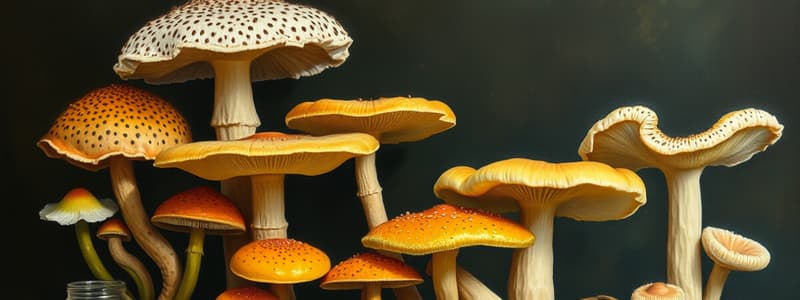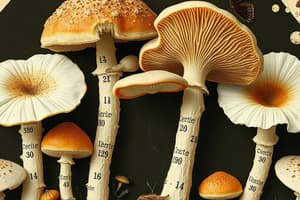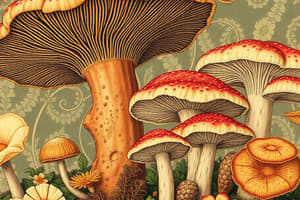Podcast
Questions and Answers
What distinguishes molds from yeasts in terms of their structure?
What distinguishes molds from yeasts in terms of their structure?
- Molds do not form colonies, but yeasts do.
- Molds have a network of hyphae, while yeasts do not. (correct)
- Yeasts reproduce primarily through spores, while molds reproduce by budding.
- Molds are unicellular, while yeasts are multicellular.
Which of the following is NOT a group into which fungi are classified based on their pathogenicity?
Which of the following is NOT a group into which fungi are classified based on their pathogenicity?
- True pathogens
- Opportunistic pathogens
- Incidental pathogens (correct)
- Saprobic pathogens
What is the primary mode of reproduction for yeasts?
What is the primary mode of reproduction for yeasts?
- Asexual through spore formation
- Sexual through hyphal fusion
- Sexual through binary fission
- Asexual through budding (correct)
Which of the following fungal pathogens primarily affects the lungs and central nervous system?
Which of the following fungal pathogens primarily affects the lungs and central nervous system?
What characteristic is commonly associated with mold colonies?
What characteristic is commonly associated with mold colonies?
At what temperature do dimorphic fungi commonly exhibit their yeast form?
At what temperature do dimorphic fungi commonly exhibit their yeast form?
What is the medical term for diseases resulting from fungal infections?
What is the medical term for diseases resulting from fungal infections?
What is the primary temperature for mold to form and exhibit temperature-dependent morphology?
What is the primary temperature for mold to form and exhibit temperature-dependent morphology?
Which term refers to fungi that can live as parasites in humans?
Which term refers to fungi that can live as parasites in humans?
What is the process called when a fungus converts from its filamentous form to yeast upon mammalian infection?
What is the process called when a fungus converts from its filamentous form to yeast upon mammalian infection?
What role do saprobes play in their ecosystem?
What role do saprobes play in their ecosystem?
Which of the following fungi is classified as a critical priority pathogen according to WHO?
Which of the following fungi is classified as a critical priority pathogen according to WHO?
Which of these fungi is categorized as an opportunistic pathogen?
Which of these fungi is categorized as an opportunistic pathogen?
Which of the following is a principal drug prescribed for systemic mycoses?
Which of the following is a principal drug prescribed for systemic mycoses?
What defines true fungal pathogens in terms of their adaptability?
What defines true fungal pathogens in terms of their adaptability?
Which of the following is NOT a characteristic of opportunistic pathogens?
Which of the following is NOT a characteristic of opportunistic pathogens?
Which type of pathogenic fungi typically does not require a host for infection?
Which type of pathogenic fungi typically does not require a host for infection?
What is the secondary drug choice for treating systemic mycoses, often prescribed after Amphotericin B?
What is the secondary drug choice for treating systemic mycoses, often prescribed after Amphotericin B?
Which of the following molds primarily converts to a yeast form at 37ºC during host infection?
Which of the following molds primarily converts to a yeast form at 37ºC during host infection?
What is the primary treatment for Pneumocystis pneumonia (PCP)?
What is the primary treatment for Pneumocystis pneumonia (PCP)?
What are the free-living spores of Coccidioides immitis called?
What are the free-living spores of Coccidioides immitis called?
What percentage of coccidioidomycosis cases show no apparent primary pulmonary infection (PPI)?
What percentage of coccidioidomycosis cases show no apparent primary pulmonary infection (PPI)?
What condition is primarily caused by Sporothrix schenckii?
What condition is primarily caused by Sporothrix schenckii?
Which group of individuals is most susceptible to coccidioidomycosis?
Which group of individuals is most susceptible to coccidioidomycosis?
What type of infection does Candida albicans most commonly cause?
What type of infection does Candida albicans most commonly cause?
Which antifungal agent is not effective in treating Pneumocystis pneumonia?
Which antifungal agent is not effective in treating Pneumocystis pneumonia?
What is the causative agent of blastomycosis?
What is the causative agent of blastomycosis?
What is a common treatment option for severe dermatophyte infections?
What is a common treatment option for severe dermatophyte infections?
Which symptom is NOT typically associated with mild primary pulmonary infection (PPI) of blastomycosis?
Which symptom is NOT typically associated with mild primary pulmonary infection (PPI) of blastomycosis?
What is a side effect associated with the treatment of Pneumocystis pneumonia?
What is a side effect associated with the treatment of Pneumocystis pneumonia?
Cutaneous mycoses are primarily caused by infections of which part of the body?
Cutaneous mycoses are primarily caused by infections of which part of the body?
Which type of dermatophytoses causes infections of hair and nails?
Which type of dermatophytoses causes infections of hair and nails?
What does the term 'lymphocutaneous' refer to in sporotrichosis?
What does the term 'lymphocutaneous' refer to in sporotrichosis?
What is a characteristic symptom of vulvovaginal candidiasis?
What is a characteristic symptom of vulvovaginal candidiasis?
Which species is NOT associated with causing dermatophytoses?
Which species is NOT associated with causing dermatophytoses?
What type of treatment is required for patients with disseminated coccidioidomycosis?
What type of treatment is required for patients with disseminated coccidioidomycosis?
What type of patients is predominantly affected by opportunistic infections like candidiasis?
What type of patients is predominantly affected by opportunistic infections like candidiasis?
What is a common symptom of severe chronic blastomycosis?
What is a common symptom of severe chronic blastomycosis?
What is the primary route of infection for Sporothrix schenckii?
What is the primary route of infection for Sporothrix schenckii?
What is the recommended treatment for recurrent bouts of vulvovaginitis?
What is the recommended treatment for recurrent bouts of vulvovaginitis?
Which laboratory method is specifically used to detect Cryptococcus neoformans in cerebrospinal fluid?
Which laboratory method is specifically used to detect Cryptococcus neoformans in cerebrospinal fluid?
What type of agar is commonly used for the culture of fungi?
What type of agar is commonly used for the culture of fungi?
What clinical manifestation is seen with a lung infection caused by Cryptococcus neoformans?
What clinical manifestation is seen with a lung infection caused by Cryptococcus neoformans?
Which method relies on the binding of a dye to fungal cell walls and fluorescing under UV light?
Which method relies on the binding of a dye to fungal cell walls and fluorescing under UV light?
What type of fungal infection does C. albicans primarily cause?
What type of fungal infection does C. albicans primarily cause?
Flashcards are hidden until you start studying
Study Notes
Fungi as Infectious Agents
- Fungi consist of unicellular and multicellular eukaryotes, functioning as saprobes, symbionts, or parasites.
- They are classified into their own kingdom due to unique morphological, biological, and molecular features.
Classification of Fungi
- Divided into yeasts and molds based on macroscopic and microscopic characteristics.
- Fungal infections in humans, known as mycoses, arise primarily from yeasts and molds.
- Fungi are categorized by pathogenic virulence: systemic, subcutaneous, cutaneous, or superficial.
- Fungi are further divided into true pathogens and opportunistic pathogens based on their ability to cause disease.
Molds
- Multicellular fungi with filamentous structures called hyphae, forming a network known as mycelium.
- Reproduce through spores, which can be sexual or asexual, giving colonies a fuzzy appearance.
Yeasts
- Unicellular fungi that reproduce asexually by budding or binary fission.
- Commonly appear as smooth, creamy colonies on culture media.
- Notable genera:
- Candida (causing oral thrush and vaginal infections).
- Cryptococcus neoformans (causing cryptococcosis affecting lungs and CNS).
Dimorphic Fungi
- Exist in two forms: yeast at body temperature (35-37°C) and mold at environmental temperatures (25-30°C).
- Examples include Histoplasma capsulatum, Blastomyces dermatitidis, and Coccidioides immitis.
Pathogenic Fungi
- Around 300 fungi are pathogenic to humans, displaying diverse phenotypes in the environment.
- WHO classification includes:
- Critical priority: Cryptococcus neoformans, Candida auris.
- High priority: Candida glabrata, Histoplasma spp..
- Medium priority: Scedosporium spp., Pneumocystis jirovecii.
Types of Pathogenic Fungi
-
True Pathogens:
- Capable of invading healthy hosts; exhibit thermal dimorphism.
- Treatment often involves amphotericin B or fluconazole.
-
Opportunistic Pathogens:
- Primarily affect immunocompromised individuals; non-communicable in nature.
- Examples: Aspergillus, Candida, and Pneumocystis.
Coccidioidomycosis
- Caused by inhaling arthrospores; presents initially as a mild, often unapparent infection but can progress to severe illness in susceptible populations, such as AIDS patients.
- Diagnosed through unique spherules in fluids or tissue samples, requiring amphotericin B for treatment.
Blastomyces dermatitidis
- Causes blastomycosis characterized by respiratory symptoms and can disseminate to other body organs.
- Manifestations include chronic infections leading to systemic complications.
Cutaneous Mycoses
- Infections of keratinized skin, hair, and nails, known as dermatophytoses or ringworm, caused by Trichophyton, Microsporum, and Epidermophyton.
- Treatment includes topical antifungal agents like miconazole and griseofulvin for severe cases.
Pneumocystis jiroveci
- Causes Pneumocystis pneumonia (PCP), particularly dangerous for AIDS patients.
- Treatment usually involves cotrimoxazole; conventional antifungals like amphotericin B are ineffective.
Subcutaneous Mycoses
- Sporothrix schenckii causes sporotrichosis, often contracted through gardening injuries.
- Lymphocutaneous sporotrichosis manifests via local skin nodules that spread to lymph nodes.
Opportunistic Mycoses
- Candida albicans leads to candidiasis, prevalent in immunocompromised individuals.
- Thrush and vulvovaginal infections can arise, alongside cutaneous candidiasis in moist skin areas.
Cryptococcus neoformans
- Causes cryptococcosis, particularly in immunocompromised patients, with symptoms including cough, fever, and potential CNS involvement.
- Treatable with amphotericin B and fluconazole; immediate medical attention is critical.
Diagnosis of Fungal Infections
- Methods include clinical assessment, microscopy, cultures, serological tests, and molecular techniques (e.g., PCR).
- Microscopic diagnostics involve special preparations (e.g., KOH, Calcofluor White, India Ink for Cryptococcus).
Culture Techniques
- Sabouraud Dextrose Agar (SDA) is commonly used for the cultivation of fungi.
Studying That Suits You
Use AI to generate personalized quizzes and flashcards to suit your learning preferences.




